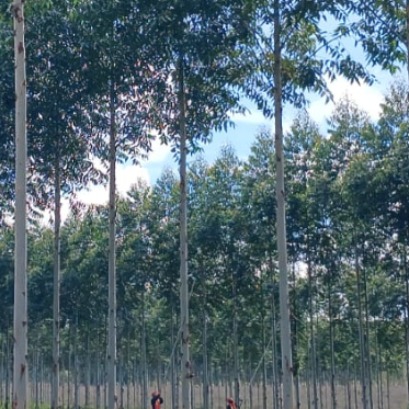
José Olinuck says goodbye to INTA after 47 years: a life dedicated to agrometeorology and the service of agricultural production
With an exemplary career of almost half a century, the agrometeorologist coach José Olinuck retires from INTA Cerro Azul leaving for the productive sector of the NEA an invaluable statistical work on temperatures, rains and other weather conditions, in addition to the consolidation of a network of agrometeorological stations. His silent, meticulous and constant work allowed himself to anticipate the weather and improve the decisions of thousands of producers. When in 1978 José Olinuk entered the INTA Cerro Azul as a coach to take care of the area of ??Agrometeorology, he surely did not imagine that his work would mark over fire the development of this discipline in the region. Today, a few days after his retirement, he reviews with emotion a whole life dedicated to observing the climate, collecting data, issuing newsletters and, above all, being a reliable source of information for producers, researchers, teachers and students.
Agrometeorology, a relatively new branch within agricultural science when he began, was his vocation and his specialty for 47 years. The weather influences everything: yields, soil care, irrigation, humidity, frost, extreme temperatures, water balance, and each crop has its moment. It was essential of agrometeorological stations. Because its impulse, more than 40 stations were installed in missions and the northeast of Corrientes, covering areas such as Andresito, San Pedro, San Antonio, Iguazú, Virasoro, Liebig and Playadito. ?We receive all that information in Cerro Azul, we load it, update and generate bulletins that are available for investigations or for those who need them, free The technician explains, in statements to the local radio station Radio Estación Azul. This sustained effort transformed the INTA Cerro Azul into a key climate information node. It is a very wide network that allows us to understand the behavior of the weather in a region with a complex topography. That was essential to accompany the producer, says Olinuck. Of the envelopes to real time: the technological changes for many years were worked on paper, and the whole record was by hand. At the end of the month, we sent the envelopes with the forms to the Castelar Eea, he recalls with a smile. The technological transformation came strongly in the last 20 years: Now the stations are automatic, the information is loaded daily online and is available in real time, from anywhere in the world, he said. This progress allowed not only to improve the accuracy of the data, but also to expand access. Today the data is available for researchers, universities, technical schools, producers. It is a collective heritage, and I am proud to have contributed to that, he says. A legacy for the futureJojosé does not leave at all: he leaves a structure working and a professional team that will continue his work. A new professional joins the area, and I know that he will do it very well. INTA is a solid institution, and Cerro Azul is a very valuable place, he says. The producers of the region recognize their career with gratitude, and he says goodbye with humility: ?For me it was a pride All, ?he said, his work was highlighted and recognized in the edition of the Rural Expo of Missions 2022, organized by the Rural Society of Misiones. With its retirement, one stage is closed and another will continue, in a context where the Agrometeorology charges an even more relevant role in the face of the challenges of the climate crisis. Its history, marked by commitment and constancy, leaves a deep mark on the body and in the agricultural history of the region.
IT MAY INTEREST YOU
 The second largest wetland in South America is located in Argentina: what is it?
The second largest wetland in South America is located in Argentina: what is it?
Argentina has national parks that place it in a unique position within South America, competing with 300 others. Which is the largest? South America is home to more than 300 national parks, but many go unnoticed. There are extensive wetlands that have been the subject of major ecological restoration projects, to coastal mountains with deep indigenous heritage. Today we tell you the case of one located in Argentina.
 Missions | New illegal felling in the Piñalito Provincial Park in San Pedro reveals the silent expansion of deforestation in protected areas
Missions | New illegal felling in the Piñalito Provincial Park in San Pedro reveals the silent expansion of deforestation in protected areas
The advance of deforestation on protected areas was once again evident this week in the Piñalito Sur Provincial Park, in San Pedro, where the Ministry of Ecology and Renewable Natural Resources confirmed a new case of selective illegal logging. The event occurs in a context of growing concern about the fragility of the environmental control system in rural and border areas, where the scarcity of resources, personnel and logistics limits the capacity of surveillance against criminal organizations organized to steal native woods and market them on the black market in connivance with sawmill owners.
 Paraguay | The plantations became instruments of territorial development and the generation of decent employment, INFONA highlights.
Paraguay | The plantations became instruments of territorial development and the generation of decent employment, INFONA highlights.
Plantings in different phases, control of ants and weeds, pruning and thinning, mechanized harvest, technology applied to the field and complete integration of the production cycle were part of the CREA Forestal proposal in its Technical Update Conference – JAT Forestal 2025. The event took place on Friday, November 14, at Estancia Ñemity, located in San Juan Nepomuceno, Caazapá, where agricultural producers, technicians, contractors, students and companies in the sector met to observe the forestry business of the future in action.





















